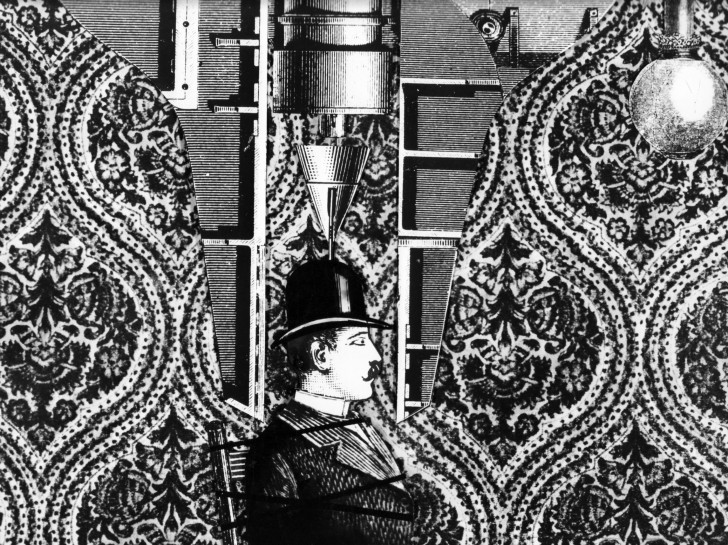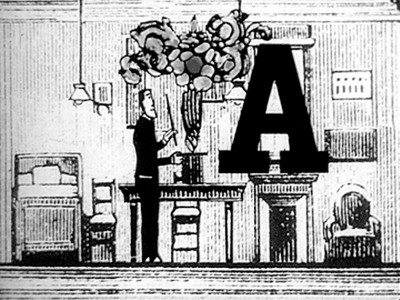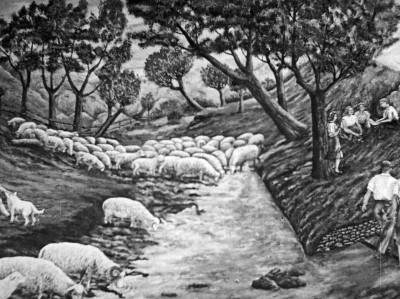Audio transcription
John Quackenbush 0:00
December 2, 2017. The Harvard Film Archive screened short works by Jan Lenica. This is the introduction by HFA Director Haden Guest and film scholar Grzegorz Skorupski.
Haden Guest 0:14
Good evening, ladies and gentlemen. My name is Haden Guest. I'm director of the Harvard Film Archive, and I'm really thrilled to be here for the opening night of a three-part retrospective dedicated to the great late Polish animator Jan Lenica. Lenica has a very special place in the history of the Harvard Film Archive and the University because he taught here for a number of years, teaching animation. Tomorrow night, we will see a documentary that was made, a portrait of Jan Lenica made by Dick Rogers, Richard P. Rogers, who was an important film professor here. And that, that film is shot in the, in classrooms at the Carpenter Center. So definitely come for that quite remarkable film. Here tonight to say some words about Jan Lenica we have a near and dear friend from the Adam Mickiewicz Institute, which is an important Polish cultural institution. This is Grzegorz Skorupski, please join me in giving a very warm round, round of applause.
[APPLAUSE]
Haden Guest
The job of putting together this program was quite an extraordinary feat. Jan Lenica’s, many of Jan Lenica’s films have not been screened in this country for a very long time. And so it became something of a detective’s work, an archaeologist’s work. And Grzegorz became a kind of Indiana Jones-like figure, digging deep into the archives of Poland, Germany, elsewhere. Fortunately, the Harvard Film Archive has some copies of Lenica’s films. So don't be surprised if you see an historic “from the Harvard Film Archive collection” image before some of these prints that we're going to see. So I want to thank you, Grzegorz, for being here tonight, for all the work you did, and all the work that you do at the Adam Mickiewicz Institute to bring Polish culture and cinema to the universities and cinematheques and museums across this country and around the world. I also want to thank you, as well, for the lovely reception that we just enjoyed. And now we're all full of pierogis and other treats. And that's the perfect state to be in to enjoy these extraordinary films!
[APPLAUSE]
Haden Guest
And now, Grzegorz. Thank you very much.
[APPLAUSE]
Grzegorz Skorupski 2:44
Good evening, everyone. Think I'll use this microphone. Good evening, everyone. Thank you very much for inviting me here. And as Haden mentioned, we have been working on this program for a number of years. I think we started to think about it on 2013. So finally, it's going to happen this evening, and I'm really happy with that. Thank you very much Haden. Thank you very much, Brittany, that helped us on, on the program. And thank you very much for having us here. I'll give you a few words about Jan Lenica and his films. But before that, I'd like to mention Adam Mickiewicz Institute, the institution that I work for, and give you this idea what we are doing, and why we are doing what we're doing. So Adam Mickiewicz, our patron, was a romantic poet. You can find his monuments in nine different cities in Poland, but also you can find his monuments in Paris, in Lvov, and some other foreign countries. He was a friend of Goethe, he received a pen from Goethe. And in 19th-century Europe, it was, it was a kind of something comparable with Nobel Prize. He translated George, Lord George Byron into Polish. He was first student professor at Collège de France, because he used to live in Paris. But also, he was opium smoker, a womanizer, with a great passion for alcohol. So I would say he was a Jim Morrison-slash-Umberto Eco of the 19th century. If the punk rock music would be invented in 19th century, I'm sure Adam Mickiewicz would be a leader of one of the greatest bands during that time. So can you imagine a better patron for the cultural institution? I can't. And I believe we got a bit of this spirit in Adam Mickiewicz Institute. So we promote Polish, actually, we don't say “promote,” we say we “tell” Polish culture to the foreigners. Obviously the [?Mayan stone?] culture like Chopin, but even more the artists like Jan Lenica. So the ones who are not that well known around the world, but got this artistic spark, or had got this artistic spark. So now, let me tell you a few words about Jan Lenica. So the film director, and critic, the arts critic, script writer, graphic designer, but first of all, the great artist, with a huge and open horizons for, for the artistic feeling. And everything began in 1957, where two young filmmakers, Jan Lenica and Walerian Borowczyk, decided to make films. Before, they were graphic designers, and they were working as a graphic designers. But in 1957, they decided to make films. And that was quite special time in Poland, or in Europe generally. Because as you may know, when Joseph Stalin died on the beginning of the 50s, something had changed. People start to think that they can get more freedom, they can think about freedom. The social realistic arts just ended. And the new chapter was beginning. And that was visible on different levels of the social life, including culture, of course. And the something called “avant-garde” became very modern, and people started to think about avant-garde like about something that introduced them to freedom. And avant-garde was one of the crucial things that we can say about films of Jan Lenica and Walerian Borowczyk during that time. If you can imagine, their first film, titled Once Upon a Time, first of all, was very avant-garde. They took graphic design on a very, on a, on a different level. Because before then, graphic design, animation, was considered as a tool in telling the stories for children. So the animation was just a tool to say the story. But Jan Lenica and Walerian Borowczyk, they took animation, and put them par excellence as an art. That was very avant-garde during that time. In their first film, Once Upon a Time, you can see that avant-garde, and you can hear jazz music, which was something quite absolutely unexpectable during that time in Poland. That was a really spirit of freedom. They've done a few films together, just a few films, maybe. The three of them are a bit longer, the rest is a very short one, we are going to see all of them this evening, tomorrow, and on Monday. The first one, Once Upon a Time. The second one, Love Requited, it's going to be screened on, in a moment, you're going to see that. And for that one, I'm going to translate the sentences that are in the film. And let me stop with this title for a second. Because when you think about work of art created about two authors, you always try to figure out which part of the work of art came from which artists. That's what the film critics are trying to do since the, 57, 1957. And that picture is quite, quite a good example. Because there is a key for, for that. Walerian Borowczyk was much more into film, so, photographs. After they split, he went on into the feature films, he ended up doing the erotic films. But I believe that's for, that's a story for another meeting. So the film side of the, their works is much, is more for, from Borowczyk. The graphic design and animation, or inspiring, or getting the inspiration from classical cinema, but using the animation to express that, is more Jan Lenica. And in the film Love Requited, you can see quite nice example of that. The film does not have the dialogues, but you have the sentences which are screened between the scenes, giving a good idea what the protagonist thinks, what's going to happen on screen. And that's the straight inspiration from the silent movies which were kind of a passion of Jan Lenica. Right, let's step forward. So the third film, and the last film of this duo, is titled House. It had been made in 1958. And it won the Grand Prix in Brussels at avant-garde, sorry, the experimental film festival. And that was a kind of a breaking point in their careers, because it was the last film, so they decided to split and each of them went his own way. But that film put them on the other level. Since that film, and that Grand Prix, the film critics, or they began the filmmakers, that film critics are waiting for their next film. And they really delivered, I mean, next films by each of them were receiving the prizes, and were very interesting and well received by the critics and the audience. So now coming back to Jan Lenica. The, one of the tastes about his cinema is chasing those inspirations that are taken from classic cinema. And of course I won't give you more examples, because I think that's something interesting. So I hope you'll find those inspiration in the films that you are going to see in a moment. Just to give you a bit more information about the history. After the 1957, when they started, and they start to be recognizable, more and more, authorities in Poland realized what was the idea of making films by Jan Lenica. If you will see all of his films, you'll, you'll see that they are, they got something in common. Jan Lenica himself was saying that he's not making different films, he's making one big film, it’s just cut into four pieces. In all of those films, or in most of these films, you can see the protagonist, who's a kind of outsider, dealing with, you would say, with a system, or with environmental or the situation that is trying to affect him. And obviously, the censorship in Poland realized that these are the allegories of the totalitarian system. And more and more, he had problems with releasing his films or putting them on screen in Poland. And that was one of the reason, probably the biggest one, that he decided to move to Paris. So he moved to Paris and started to work up there. Later on, he came to United States, and as Haden mentioned, he used to be here, maybe even in this screening room, running the lectures about the history of poster and graphic design. After United States, he moved to Germany, and started to work up there and cooperating with universities in Germany. He came back to Poland after the political changes in 1989. And after a long, long break, he started to make his final film. Unfortunately, he didn't make it to the end. The title of this one is The Island of R.O. It had been finished after his death. It's going, we are going to screen it tomorrow. And so now let me tell you a few words about the films that you are going to see in a moment. The first one is titled A, the letter A. And it had been made in 1964. It is a very nice sample of the metaphor of protagonist that is trying to fight against the totalitarian system, which is personalized by the letter A. It's a very simple film, almost theatrical, because the camera is just showing the stage. Even the things that are appearing on the film coming from the sides, like, like on a theater stage. So, so that's a metaphor, like, like most of this film. The next one that we are going to see is Striptease. It's one of the films that had been made together with Walerian Borowczyk in 1957. So one of the first films. And that's a joke film, I would say. It's just two minutes, and it had been made for the newsreel that had been created on the occasion of celebrating the Education Day in Poland in 1957. When we will screen the film, I will take the microphone and explain few things which are on screen for you. Because there is no dialogues, but there are some sentences. These are the headlines from the Polish newspapers. So you need to know what was there to understand the film. The next film that is going to be screened is Home, from 1957. And that's, that's the real Surrealistic film, the Surrealistic vision of a home. And again, that's a good sample of chasing the parts that had been made by Walerian Borowyczk and Jan Lenica. You'll find the graphic designer, Jan Lenica, the animator, and Walerian Borowyczk with the inspiration of doing the feature films. One of the ideas is, is a wig that is climbing on the table and then climbing on a bottle and drinking out the milk from the bottle. That's something very typical for, for the imagination of Walerian Borowczyk. The next film that we are going to see is Love Requited, from 1957. So again, a picture that had been made by both of them, and that's the film which is based on naive paintings. The paintings have been made by Walerian Borowczyk, Jan Lenica. and, and one of the Polish naive painters. And it's a love story. You'll see the story of the young, shy gentleman looking for love.
16:32
The next film that is going to be screened is The Flower Woman, La femme-fleur. That, that one was made when Lenica was in France. And that one is a bit different. That one introduces us to one of the passions of Jan Lenica. He was very keen on Art Nouveau arts. And that's a kind of glorification of this Art Nouveau arts. The next film had been made in 1962, and the title of it is Labirynt. And I believe that's the most well known film by Jan Lenica. When you will see it, I'm sure you can recognize some of the pictures. Or maybe you've seen some of those pictures that were the inspiration for the other artists. For example, Terry Gilliam, the animator from Monty Pythons, was, was very inspired by, by this picture. I'm sure you can see the, the traces of Monty Pythons in this one. Or maybe you can see traces of this one in Monty Pythons animations. The next film that is going to be screened is Rhinoceros from 1963. And that's the film which is, I would put it together with another film of Jan Lenica that's going to be screened tomorrow, Monsieur Tête. So, Mr. Head. And again, that's a very clear sample of this outsider trying to face the oppressive system. And I won't take your time anymore, because probably, I'm sure it's much better to see the films not, and then to talk about them. So please be invited to this dream, as Jan Lenica said, because he was, he was saying that his films are, or his film, because he was saying that he's making this one big film, is a Surrealist dream. So enjoy the films. Thank you.
[APPLAUSE]
© Harvard Film Archive











